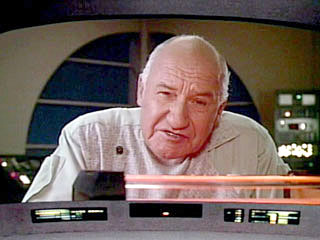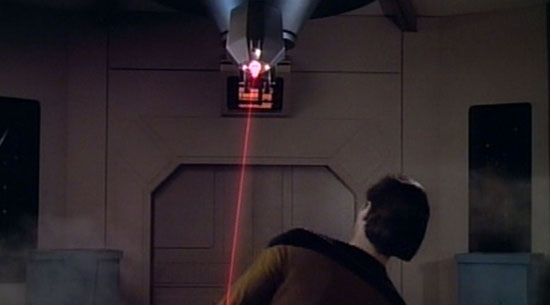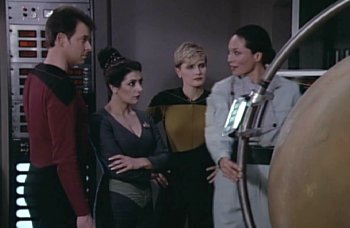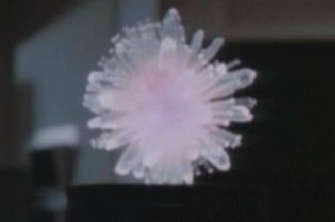“Home Soil”
Written by Karl Guers, Ralph Sanchez, and Robert Sabaroff
Directed by Corey Allen
Season 1, Episode 17
Production episode 40271-117
Original air date: February 22, 1988
Stardate: 41463.9
Captain’s Log: The Enterprise checks up on Velara III, a terraforming project that hasn’t been in touch much lately. When they arrive, Director Mandl is crotchety, cranky, and abrasive. Riker beams down over his objections, where they are given a tour by Luisa Kim, who is younger, prettier, dippier, and a lot more friendly. Kim’s enthusiasm is as infectious as Mandl’s snottiness is off-putting.
Most of the first act is overrun by the Exposition Fairy, but it’s actually really cool stuff, as the team fill the crew in on how they’re turning a lifeless planet into one that can support living beings. However, the end of the act sees the hydraulics engineer performing maintenance on the laser drill only to be attacked by that drill and killed. When Data tries to reconstruct what happened, he is also attacked.
Further investigation reveals a piece of inorganic material that glows in complex rhythms. La Forge sees almost musical patterns in it. They beam it back to the ship, where Crusher, Data, La Forge, and Wes start running tests. It responds to stimulus—humming at different levels depending on whether or not it’s being scanned, or how close people are standing to it.

In the lab, the life form pulses, removes the scan from the screen, glows, and duplicates itself. Self-replication pretty much confirms that it’s alive. It then resists the quarantine field and makes a request of the computer for a translation matrix. Trying to communicate confirms that it’s intelligent life.
The terraformers thought of the energy flashes as being random energy readings, but nothing indicated that it was life, so they dismissed it.
When the translator comes online, the lifeform explains that the humans tried to kill them and refused attempts to communicate, and so they have declared war—it killed the engineer, not one of the other terraformers. The team was siphoning off the salt water that ran just underneath the surface, but that was what the lifeform needed to survive. It has taken over the medical lab and the ship’s computer—but Data and La Forge determine that it’s photoelectric, so they turn off the lights in the lab. The lifeform finally agrees to end the war and they beam it back to the surface.
Picard declares a quarantine on Velara III, and they take the surviving terraformers to a starbase.
Thank you, Counselor Obvious: In the teaser, Troi senses that Mandl is in an absolute panic over the ship’s arrival, but over the course of the episode, that’s never followed up on except as a cheap red herring. For all that Troi protests that there’s more to it than Mandl not wanting them there, ultimately, Mandl just didn’t want them there.
She also sends Riker to flirt with Kim to get information, which is just hilarious.
Can’t We Just Reverse the Polarity?: The science in this episode is actually quite good. We see the scientific method in action, everything we learn about the inorganic lifeform at least sounds convincing, and the crew act like professionals rather than people pulling nonsense out of their asses.
The lifeform refers to humans as “ugly bags of mostly water,” which is just a wonderful (and accurate, as Data points out) description.

If I Only Had a Brain : Data faces the exact same inorganic-lifeform-controlled drill that killed the hydraulics engineer. However, since he is a super-strong, super-fast android, he handles the encounter far better than a dumpy, bald hydraulics engineer, leaving a mangled drill in his wake.
The Boy!?: Wes may as well not have been in the episode for all that he contributed (two lines: one dumb question about the flashes, and one observation that the lifeform is beautiful), but he looks very serious standing around watching everyone else do all the work.
There is No Honor in Being Pummeled: Worf gets to be all science-y in this episode, right there with La Forge and Data investigating the new lifeform, and pointing out that it is, basically, a computer. The lifeform is also given the nickname “micro-brain,” the exact same nickname Q derisively gave to Worf back in “Hide and Q.”
 Welcome aboard. Walter Gotell, best known as General Gogol in the James Bond movies, is suitably aristocratic and obnoxious as Mandl. Elizabeth Lindsey, Gerard Prendergast, and Mario Roccuzzo are remarkably unremarkable as the other 75% of the team.
Welcome aboard. Walter Gotell, best known as General Gogol in the James Bond movies, is suitably aristocratic and obnoxious as Mandl. Elizabeth Lindsey, Gerard Prendergast, and Mario Roccuzzo are remarkably unremarkable as the other 75% of the team.
I Believe I Said That: “But is it alive?”
“Probability positive.”
“I wasn’t asking you.”
Worf expressing curiosity, then slapping down the computer when it sticks its nose in.
Trivial Matters: Picard comments at one point, “It seems we are becoming detectives, Number One,” referring to Picard’s own play-acting at being Dixon Hill in “The Big Goodbye,” not to mention Data’s Sherlock Holmes obsession from “Lonely Among Us.”
They also talk of inorganic life as if it’s never been encountered before, everyone having apparently forgotten the silicon-based Horta in “The Devil in the Dark.”
Make it So: “We were not looking, and therefore we did not see.” A rare instance of the Enterprise actually seeking out new life—well, in this case, stumbling across it by accident—but while this episode has its flaws, it’s a wonderful example of science fiction, one that doesn’t skimp on suspense, action, and Trek‘s trademark compassion.
Among the flaws are director Allen’s bizarre insistence on unnatural, stage-y blocking and positioning and obsession with extreme closeups; clumsy handling of the red herring of the murderer being one of the terraformers by overselling Mandl’s annoyance in the teaser; and the amnesia regarding the Horta.
The fact that the Enterprise wins the day by turning the lights down is wonderfully prosaic, and very satisfying—given that they arrived at that notion through deductive reasoning rather than a scientific principle the writer made up. It’s, in many ways, the perfect Star Trek story, even with its imperfections as a Star Trek episode.
I freely admit that I like this one more than most, but it’s always had a warm place in my heart for its intelligence and for the joy taken in exploration, both of the new lifeform and of the planet being terraformed.
Warp factor rating: 7.
Keith R.A. DeCandido‘s most recent novels are the high-fantasy police procedural, Unicorn Precinct (currently available for the Kindle, available in other eBook formats and trade paperback later this month, from Dark Quest Books) and the superhero police procedural Super City Police Department: The Case of the Claw (currently available in all eBook formats from Crossroad Press). Yes, he likes police procedurals. Sue him.











I have a fondness for any lifeform that has a pet name for humans:
The silicon lifeform: “Ugly bags of mostly water”
HK-47 (Star Wars: Knights of the Old Republic): “…Meatbag”
It takes the humans in the narative down a peg, and they can generally use it.
Yep, the “Ugly Bags of Mostly Water” line will forever elevate this episode in my memory.
I remember thinking, “Oh, finally!” when I saw this episode. As in, finally something remotely like late-20th-century science fiction.
So few of TNG’s episodes were actually about exploration, new life forms, strange worlds, etc. And the very last episode seemed like a final betrayal.
Episodes like this one really stand out.
Not only have they forgotten the Horta, but the dozens nigh omnipotent energy beings Starfleet has encountered by this point alone you’d think would be enough to make everybody a bit leery of accidentally enraging a strange inorganic life form.
That’s a problem with the Star Trek franchise as a whole, though. So little of the amazing stuff discovered in one episode will have any impact on the next. And if they do, then it’s usually via retcon.
(Note how the symbiotic nature of the Trill went from this big, shocking reveal in TNG to “ho-hum, everyone knows that!” in DS9.)
“I remember thinking, “Oh, finally!” when I saw this episode. As in, finally something remotely like late-20th-century science fiction.”
To be fair, the Star Trek paradigm you describe of “exploration, new life forms, strange worlds,” is more “early 20th century” Science Fiction, the 1930s style stuff the original show so often did. But the literary form of SF had changed a lot by the late 80s and early 90s. Is it so surprising that the televised form had shifted focus as well?
Keith, I couldn’t agree with you more! This is a pretty good episode, one of the best of the first season.
I remember, being a kid when I first saw it, feeling somewhat excited that the things we were learning in science class actually would be of some use when we grew up! You know, seeing Dr. Crusher list the basic characteristics attributed to life, and following the scientific method… it was cool! Grownups actually using in daily life what we learned in school! :O No way! :P
Yep, I’ll also have a warm place in my heart for this episode :)
One thing leaped to mind while I rewatched this. This was one of the few Star Trek episodes (maybe the only one from TNG) to end with a Captain’s Log Entry. Usually they throw in a “recap” scene after the log is recorded. I kind of liked it this way, no preachy, moral scene at the end, just a quick recap.
The only other one I can remember ending with a log entry was DS9: “In the Cards.” I’m not gonna count “In the Pale Moonlight,” because Sisko deletes the log at the end.
I suppose there were others that ended like this, but they are not leaping to mind right now (certainly nothing from TNG).
Another TNG episode that I recall ending with a Captain’s Log was Season 3 episode “The Survivors.” Picard’s entry was about leaving the Doud alien alone.
As far as the science goes, this episode had a problem that bugged me, a problem that’s fairly pervasive in movies and TV about this sort of thing. The silicon lifeform is sitting in an isolation chamber in a lab, right? Nothing around it but air, at most. And yet it’s able to replicate itself and grow to multiple times its original mass. Where the hell is the material coming from??? I had the same problem (among others) with the macrovirus in Voyager‘s “Macrocosm,” that magical ability to grow to gazillions of times its original mass while sitting inside a containment field with no access to any kind of food to build a larger body from. It’s a pervasive trope in a lot of sci-fi, just about any story involving creatures that grow out of control or age from infancy to maturity in minutes without ever eating (with such rare exceptions as “The Trouble With Tribbles” — the fact that they needed to eat was a big part of the problem — and the recent Futurama episode “Benderama,” where the duplicator device needed a source of matter to create its duplicates from). A minor detail in this episode, but it’s so widespread and so fundamental (how hard can it be to understand that matter doesn’t come out of nowhere?) that it always bugs me.
Ugly bags of mostly water. I use that all the time with changes to the adjective, like in the case of the cats, it’s furry bags of mostly water. This episode, and the one where the society communicates completely in metaphores from their cultural myths and therefore cannot be understood are some of my favorite episodes of any tv show or book. They make you think and the’re entertaining.
forgot the “y” in they’re entertaining
That ep is “Darmok” and is one of my favorite TNG eps! :D
Wasn’t the “ugly” bag of mostly water specifically Picard?
anony: No, the “ugly bags of mostly water” was a general reference to humanity.
—Keith R.A. DeCandido
I think for it to refer to Picard, it would have to be “Ugly Shakespearian actor-bag of mostly water”!
I hadn’t realized Mandl was General Gogol! Thanks for that!
Agree that this is one of their better pure science-fiction episodes, flawed as it may be.
I thought the voice of the microbrain was a bit goofy, though. Reminded me of Nomad.
Definitely in the top-10 of the first season episodes. It follows the first season formula of visiting a planet each week and getting involved in an issue or problem. Now, my memory may be faulty, but was the Horta considered an inorganic lifeform, or was its inability to be recognized on life sensors because it was silicon-based life, rather than carbon?
It’s a great story, and the Data/Geordi/Worf scene where they analyze the life form is wonderful. The terraforming aspect is a sci-fi natural, and given how uneven TNG season 1 is, much kudos that this story was given serious treatment.
Even if this is not the first time the Federation has encountered silicon-based life forms (Horta), but that’s a minor nitpick…
And it’s a shame some of the acting comes across wooden when jubilance was needed…
“ugly bags of mostly water” = wonderful perspective, and a technical truism.
Rewatching all the TNG episodes at the moment, and realising how bad some of them are, so I very much enjoyed this one. But while you are discussing Horta and various energy lifeforms, the first thing that occurred to me was, everyone is expressing surprise at a crystalline lifeform, yet they already encountered a massive one just six episodes earlier in the Datalore episode.
Somehow I missed this episode when TNG was new and only watched it a couple of days ago for the first time. What a nice little story! The terraforming project, “ugly bags of mostly water”, and of course the moral. Just beautiful.
Also, those terraformers wear the most stylish lab clothing I’ve ever seen. And I was delighted that one of them was a woman, especially after the stereotypical housewife of two weeks ago.
I was wondering, though: How does the life form get the salt water it needs to survive when it sits under a quarantine seal in the medical lab?
@9. Christopher, this is exactly why I couldn’t get past the first episode of The Orville. A tree needs only time to grow?? What about water, light, food? I rationalized it here, thinking perhaps the life form could convert the energy in light to matter. Regardless, I really like this episode.
I enjoyed this episode more intellectually than I did viscerally/emotionally. But I do think it’s one of the first episodes in the series where they figured out what was going to work. Troi is useful and not just reporting vague feelings. Picard is serious with a little wink. We have become self-aware about Riker’s flirtations, and yet he is also more grounded and serious, and resists actually hooking up. Data is kickass but understated. Tasha has stuff to say and do. Wesley is around but not obnoxious. Dr Crusher is serious and smart but also creatively philosophical.
Science wins the day. All of it is plausible and none of it is technobabble. The future is better but we’re still not that great. And there’s a preachy moral about colonialism/manifest destiny/etc.
Still, it’s slow paced, and very little happens before the last like 15 minutes. The murder and then Data beating the laser are cool, but then there’s a long, dead, talky period. Things are unnecessarily stretched, like when the alien begins to talk to the computer, they all leave the room. When the alien hangs up on the conversation, they don’t even try to reestablish.
The entire first 2/3rds could have happened doubletime and still felt leisurely. The actual state of danger and war and big reveals could have turned the episode into a strategy chessplaying whodunit with a thousand lives at stake… make that a whole civilization… which it sort of is like, in a yawny way, for a few minutes.
With a longer time spent under threat, the philosophical discussions would have had dramatic weight. And we could have talked about exponential growth, and how quickly it would burst the ship from within, small though it may seem.
And yeah, the voice through the translator sounded like the worst S3 TOS alien dub.
Anyway, that was more words than I meant to use. I wanted to point out that this life form could have reproduced by combining air with light. Since it took over the environmental control, and we know it likes air similar to ours, but doesn’t breathe, then I think it might be eating the air; for all we know, the environmental control was generating extra nitrogen or something while everyone was out.
Yeah – Did some googling. Vapor or gas epitaxy is the process by which crystals are grown from gases; it seems like a hitherto totally new form of life with its own rules could do that with our air. Neat!
google this to return here in 300 years: rewtch soil
@@@@@ #9 Christopher Bennett
I can’t understand your complaint about the science (which like other similar comments from you on these forums comes with quite a superior tone to it. We get that you have physics degrees, but remember – you’re not exactly unique in that respect…).
The Star Trek universe has food replicators, transporters and holodecks. These use energy to create matter based on a pattern. in this episode, we have a silicon-based life form with photovoltaic properties. The very conclusion to the episode relies on this.
Why is it so jarringly unbelievable that said life form may be able to translate energy into matter? It is clearly the case in the Star Trek universe that such a thing is possible, and the universe is a pretty damn big place.
Watching and reviewing a show which handwaves the time dilation effects of FTL travel, and matter energy conversion, while nit-picking about an organism which is apparently able to grow and replicate from light energy (only), just seems bizarre to me.
Having come across a few of your posts in a similar vein, I wonder if you should perhaps stroke your ego somewhere else?
@22/jofesh: “I wanted to point out that this life form could have reproduced by combining air with light. Since it took over the environmental control, and we know it likes air similar to ours, but doesn’t breathe, then I think it might be eating the air; for all we know, the environmental control was generating extra nitrogen or something while everyone was out.
Yeah – Did some googling. Vapor or gas epitaxy is the process by which crystals are grown from gases; it seems like a hitherto totally new form of life with its own rules could do that with our air. Neat!”
But it’s silicon-based. There’s no silicon in atmospheric gases — mainly just nitrogen, oxygen, carbon, and hydrogen. A carbon-based (or CHON-based) life form could theoretically convert air into biomass (though it would probably be very, very slow and wouldn’t explain sci-fi-style rapid growth), but not this life form. However, the air also contains dust, a fair amount of which is made of silicates like sand and clay. So maybe it could extract silicon from that. Except a silicon-based life form would probably rely on rarer substances like fluorine as part of its biochemistry.
@23/UK STNGfan: “The Star Trek universe has food replicators, transporters and holodecks. These use energy to create matter based on a pattern. in this episode, we have a silicon-based life form with photovoltaic properties. The very conclusion to the episode relies on this.”
The whole “energy to matter” thing is a myth, a fanciful idea that was retconned away by the TNG technical staffers, though it still crops up in episode dialogue from time to time. The whole idea is pretty ridiculous, since E = mc^2, and c^2 is huge. A single gram of matter, a paper clip’s worth, corresponds to an amount of energy on the same order of magnitude as the Hiroshima atomic bomb. Converting a whole person to energy, let alone six at a time, and beaming that energy at a planet would essentially be firing a weapon of mass destruction at it, if it didn’t blow up the ship first. Conversely, if replicators worked by “energy to matter conversion,” you’d need over 7 billion kilowatt-hours of energy, nearly twice the entire United States’s annual energy consumption, to synthesize a single 10-ounce sandwich. It’s an insanely impractical notion.
The official Sternbach/Okuda-approved explanation is that transporters only break objects down into their constituent particles that are beamed through subspace and then reassembled at the destination. This is the “matter stream” that has often been mentioned in dialogue. Replicators, similarly, convert existing stocks of raw material into the items they produce. The matter has to come from somewhere.
“Watching and reviewing a show which handwaves the time dilation effects of FTL travel”
There is no time dilation in FTL travel, only relativistic travel below the speed of light. A space warp is not actual motion or acceleration, it’s a topological transformation of the spacetime around the essentially motionless ship. The Alcubierre warp equations show that the passage of time inside a warp bubble is identical to the passage of time outside.
Agree with the general approval of this episode as in the best tradition of sci,-fi and Trek in general. I don’t science much, so I was pleasantly transfixed watching our heroes work to resolve the crisis. For some reason I was reminded of the original Andromeda Strain movie, which had a somewhat artificial pace do it, very methodical and deliberate.
I kind of enjoyed the fact that the life-form says buggar off for 300 years, and Picard just smiles and says he understands, but won’t commit. His quarantine of the planet is indefinite. Meaning Starfleet could lift it tomorrow, LOL
Easily one of my favorites of the first season so far. It was delirious when Microbrain spoke in a way similar to NORAD though.
@26/Fujimoto: Uh, do you mean Nomad from “The Changeling”?
@27 Right, Nomad. I misremembered it as shouting “I am NORAD!”
I too enjoy (and employ) the description “ugly bags of mostly water”. Nothing more to say but that I very much agree with KRAD’s commentary and that Walter Gotell reminds me of Rudolph’s Burgermeister Meisterburger.
I liked this episode a lot relative most of the first season. But I did keep wondering why in the Trek Universe a project as complex and difficult as terraforming would be necessary at all. There appear to be habitable planets all over the place.
@30/Michael Booth: Yeah, but habitable planets often have inhabitants. Or indigenous predators, diseases, or other hostile conditions. Not to mention that colonization is an intrinsically invasive and destructive process to the native ecosystem. It’s more ethical to terraform a lifeless world.